Construction Legislation: Critical Analysis of System, Cases
VerifiedAdded on 2022/09/26
|7
|1361
|23
Report
AI Summary
This report provides a critical analysis of construction legislation, specifically focusing on the legal implications of letters of intent within the construction industry. It examines the purpose and limitations of letters of intent, differentiating them from formal contracts and provisional agreements. The report delves into the essential elements of a letter of intent, including authorization, project definition, contract sum, and key dates, highlighting the necessary steps following the signing of such a document. Through a detailed examination of case studies, such as Ampleforth Abbey Trust v Turner Townsend Project Management and Hall and Tawse South Ltd v Ivory Gate Ltd, the report illustrates the potential risks and legal outcomes associated with reliance on letters of intent. Furthermore, the analysis covers cases like OTM Limited v Hydranautics, providing insights into the court's interpretation of intent and obligations. The report concludes by summarizing the two forms a letter of intent might take, either as an executable contract or as a request for action, and their respective legal consequences. The analysis relies on several references to provide a comprehensive understanding of the subject matter.
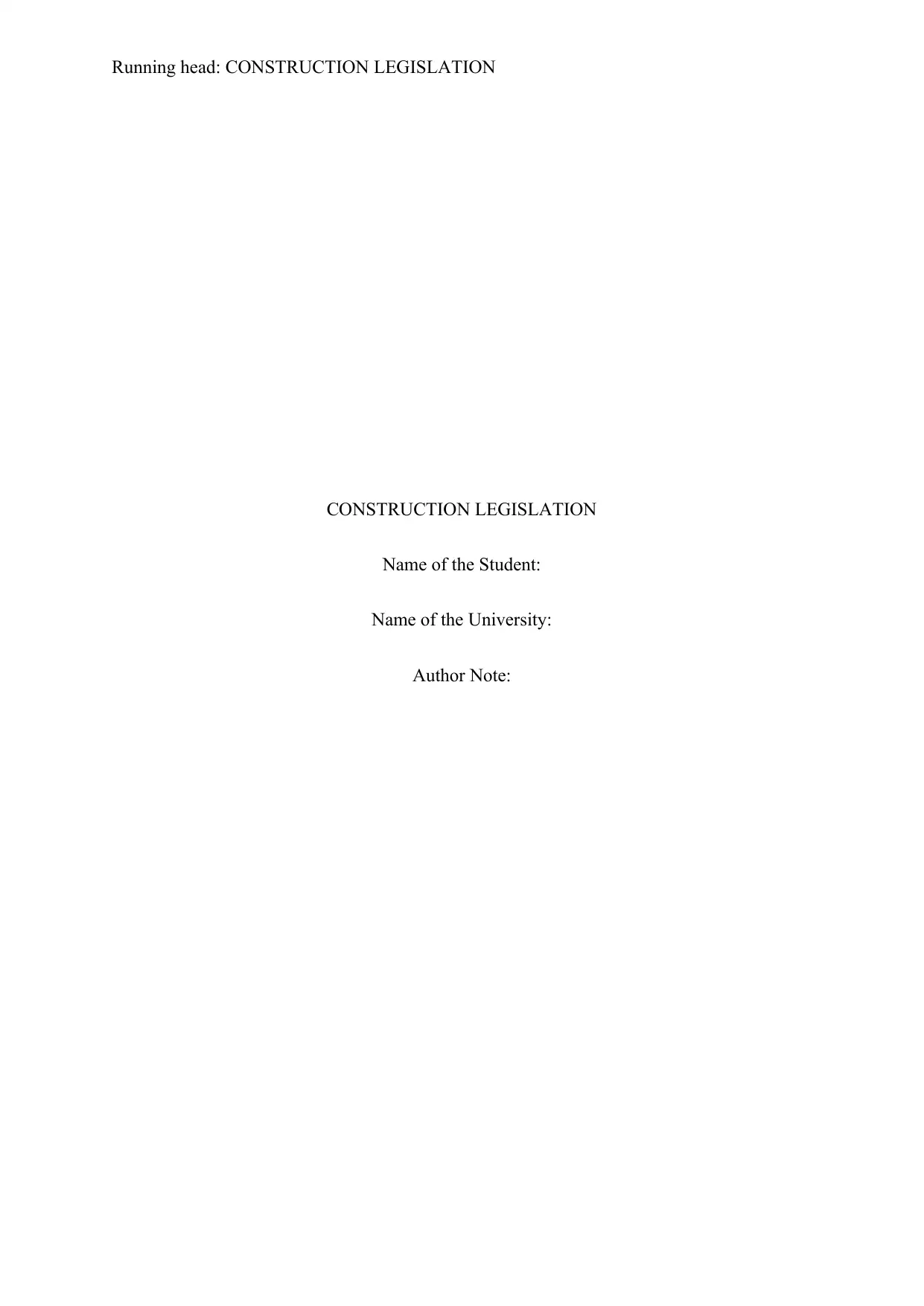
Running head: CONSTRUCTION LEGISLATION
CONSTRUCTION LEGISLATION
Name of the Student:
Name of the University:
Author Note:
CONSTRUCTION LEGISLATION
Name of the Student:
Name of the University:
Author Note:
Paraphrase This Document
Need a fresh take? Get an instant paraphrase of this document with our AI Paraphraser

1CONSTRUCTION LEGISLATION
Table of Contents
Critical Analysis of Construction Legislation System...............................................................2
References..................................................................................................................................6
Table of Contents
Critical Analysis of Construction Legislation System...............................................................2
References..................................................................................................................................6
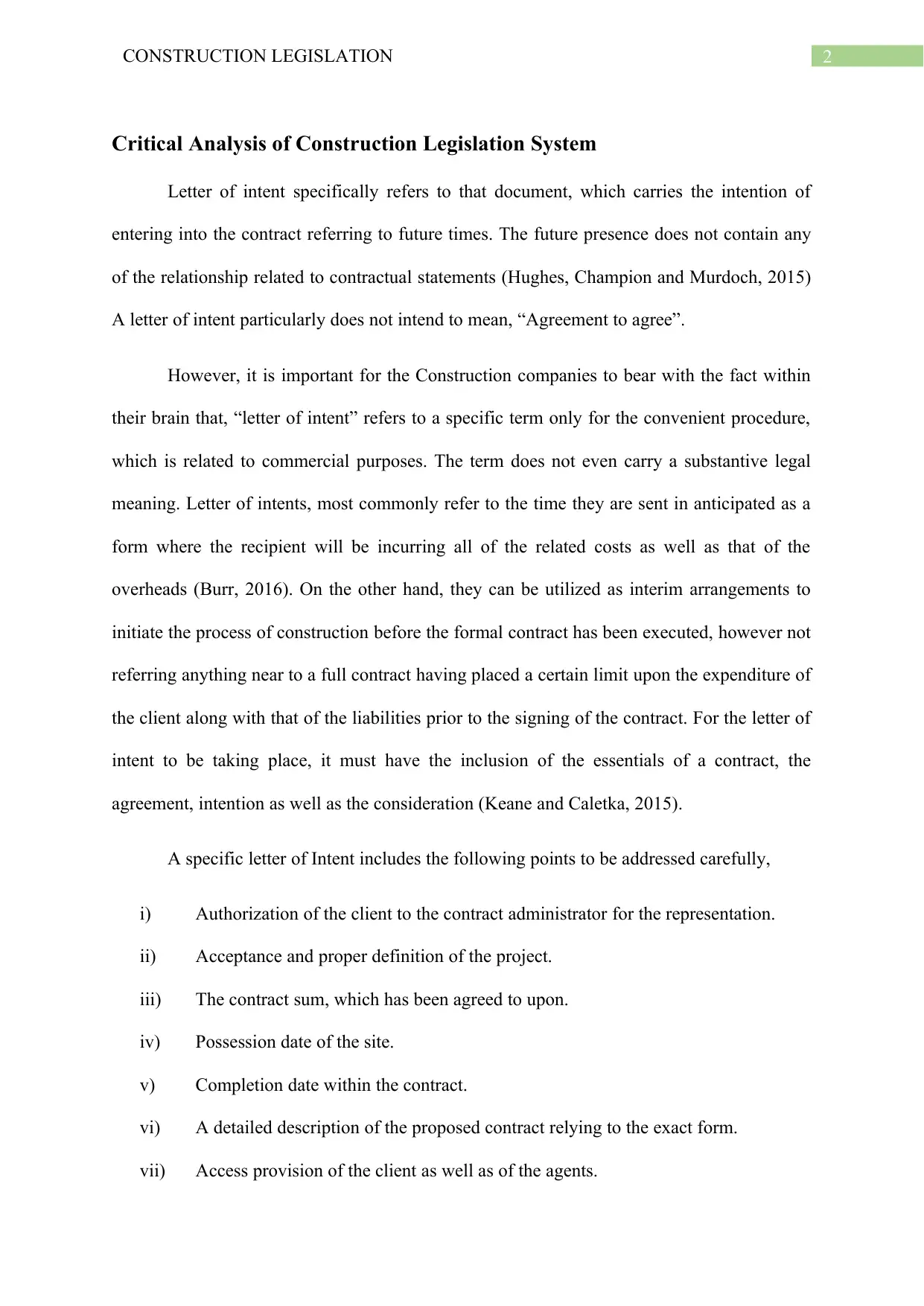
2CONSTRUCTION LEGISLATION
Critical Analysis of Construction Legislation System
Letter of intent specifically refers to that document, which carries the intention of
entering into the contract referring to future times. The future presence does not contain any
of the relationship related to contractual statements (Hughes, Champion and Murdoch, 2015)
A letter of intent particularly does not intend to mean, “Agreement to agree”.
However, it is important for the Construction companies to bear with the fact within
their brain that, “letter of intent” refers to a specific term only for the convenient procedure,
which is related to commercial purposes. The term does not even carry a substantive legal
meaning. Letter of intents, most commonly refer to the time they are sent in anticipated as a
form where the recipient will be incurring all of the related costs as well as that of the
overheads (Burr, 2016). On the other hand, they can be utilized as interim arrangements to
initiate the process of construction before the formal contract has been executed, however not
referring anything near to a full contract having placed a certain limit upon the expenditure of
the client along with that of the liabilities prior to the signing of the contract. For the letter of
intent to be taking place, it must have the inclusion of the essentials of a contract, the
agreement, intention as well as the consideration (Keane and Caletka, 2015).
A specific letter of Intent includes the following points to be addressed carefully,
i) Authorization of the client to the contract administrator for the representation.
ii) Acceptance and proper definition of the project.
iii) The contract sum, which has been agreed to upon.
iv) Possession date of the site.
v) Completion date within the contract.
vi) A detailed description of the proposed contract relying to the exact form.
vii) Access provision of the client as well as of the agents.
Critical Analysis of Construction Legislation System
Letter of intent specifically refers to that document, which carries the intention of
entering into the contract referring to future times. The future presence does not contain any
of the relationship related to contractual statements (Hughes, Champion and Murdoch, 2015)
A letter of intent particularly does not intend to mean, “Agreement to agree”.
However, it is important for the Construction companies to bear with the fact within
their brain that, “letter of intent” refers to a specific term only for the convenient procedure,
which is related to commercial purposes. The term does not even carry a substantive legal
meaning. Letter of intents, most commonly refer to the time they are sent in anticipated as a
form where the recipient will be incurring all of the related costs as well as that of the
overheads (Burr, 2016). On the other hand, they can be utilized as interim arrangements to
initiate the process of construction before the formal contract has been executed, however not
referring anything near to a full contract having placed a certain limit upon the expenditure of
the client along with that of the liabilities prior to the signing of the contract. For the letter of
intent to be taking place, it must have the inclusion of the essentials of a contract, the
agreement, intention as well as the consideration (Keane and Caletka, 2015).
A specific letter of Intent includes the following points to be addressed carefully,
i) Authorization of the client to the contract administrator for the representation.
ii) Acceptance and proper definition of the project.
iii) The contract sum, which has been agreed to upon.
iv) Possession date of the site.
v) Completion date within the contract.
vi) A detailed description of the proposed contract relying to the exact form.
vii) Access provision of the client as well as of the agents.
⊘ This is a preview!⊘
Do you want full access?
Subscribe today to unlock all pages.

Trusted by 1+ million students worldwide
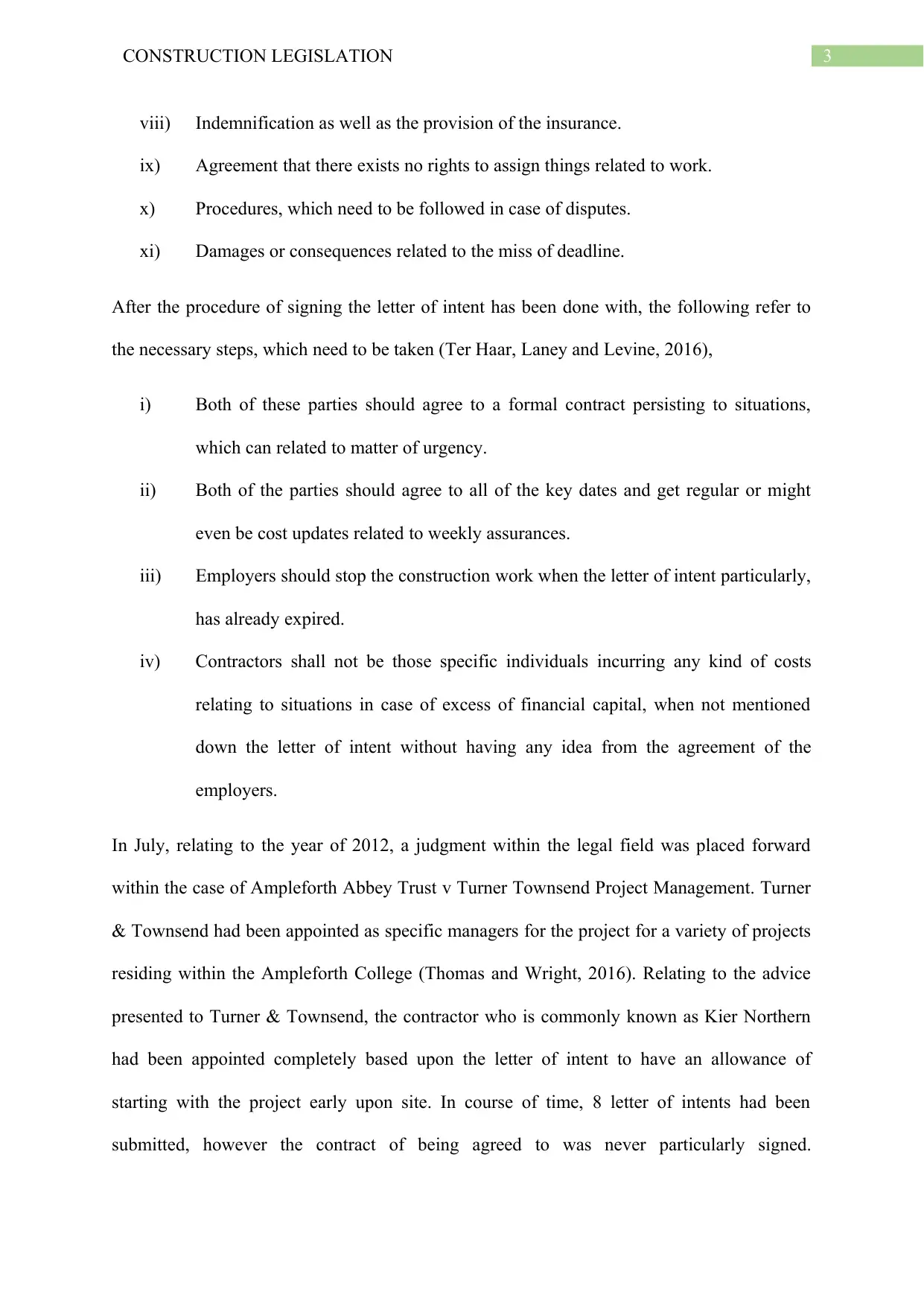
3CONSTRUCTION LEGISLATION
viii) Indemnification as well as the provision of the insurance.
ix) Agreement that there exists no rights to assign things related to work.
x) Procedures, which need to be followed in case of disputes.
xi) Damages or consequences related to the miss of deadline.
After the procedure of signing the letter of intent has been done with, the following refer to
the necessary steps, which need to be taken (Ter Haar, Laney and Levine, 2016),
i) Both of these parties should agree to a formal contract persisting to situations,
which can related to matter of urgency.
ii) Both of the parties should agree to all of the key dates and get regular or might
even be cost updates related to weekly assurances.
iii) Employers should stop the construction work when the letter of intent particularly,
has already expired.
iv) Contractors shall not be those specific individuals incurring any kind of costs
relating to situations in case of excess of financial capital, when not mentioned
down the letter of intent without having any idea from the agreement of the
employers.
In July, relating to the year of 2012, a judgment within the legal field was placed forward
within the case of Ampleforth Abbey Trust v Turner Townsend Project Management. Turner
& Townsend had been appointed as specific managers for the project for a variety of projects
residing within the Ampleforth College (Thomas and Wright, 2016). Relating to the advice
presented to Turner & Townsend, the contractor who is commonly known as Kier Northern
had been appointed completely based upon the letter of intent to have an allowance of
starting with the project early upon site. In course of time, 8 letter of intents had been
submitted, however the contract of being agreed to was never particularly signed.
viii) Indemnification as well as the provision of the insurance.
ix) Agreement that there exists no rights to assign things related to work.
x) Procedures, which need to be followed in case of disputes.
xi) Damages or consequences related to the miss of deadline.
After the procedure of signing the letter of intent has been done with, the following refer to
the necessary steps, which need to be taken (Ter Haar, Laney and Levine, 2016),
i) Both of these parties should agree to a formal contract persisting to situations,
which can related to matter of urgency.
ii) Both of the parties should agree to all of the key dates and get regular or might
even be cost updates related to weekly assurances.
iii) Employers should stop the construction work when the letter of intent particularly,
has already expired.
iv) Contractors shall not be those specific individuals incurring any kind of costs
relating to situations in case of excess of financial capital, when not mentioned
down the letter of intent without having any idea from the agreement of the
employers.
In July, relating to the year of 2012, a judgment within the legal field was placed forward
within the case of Ampleforth Abbey Trust v Turner Townsend Project Management. Turner
& Townsend had been appointed as specific managers for the project for a variety of projects
residing within the Ampleforth College (Thomas and Wright, 2016). Relating to the advice
presented to Turner & Townsend, the contractor who is commonly known as Kier Northern
had been appointed completely based upon the letter of intent to have an allowance of
starting with the project early upon site. In course of time, 8 letter of intents had been
submitted, however the contract of being agreed to was never particularly signed.
Paraphrase This Document
Need a fresh take? Get an instant paraphrase of this document with our AI Paraphraser
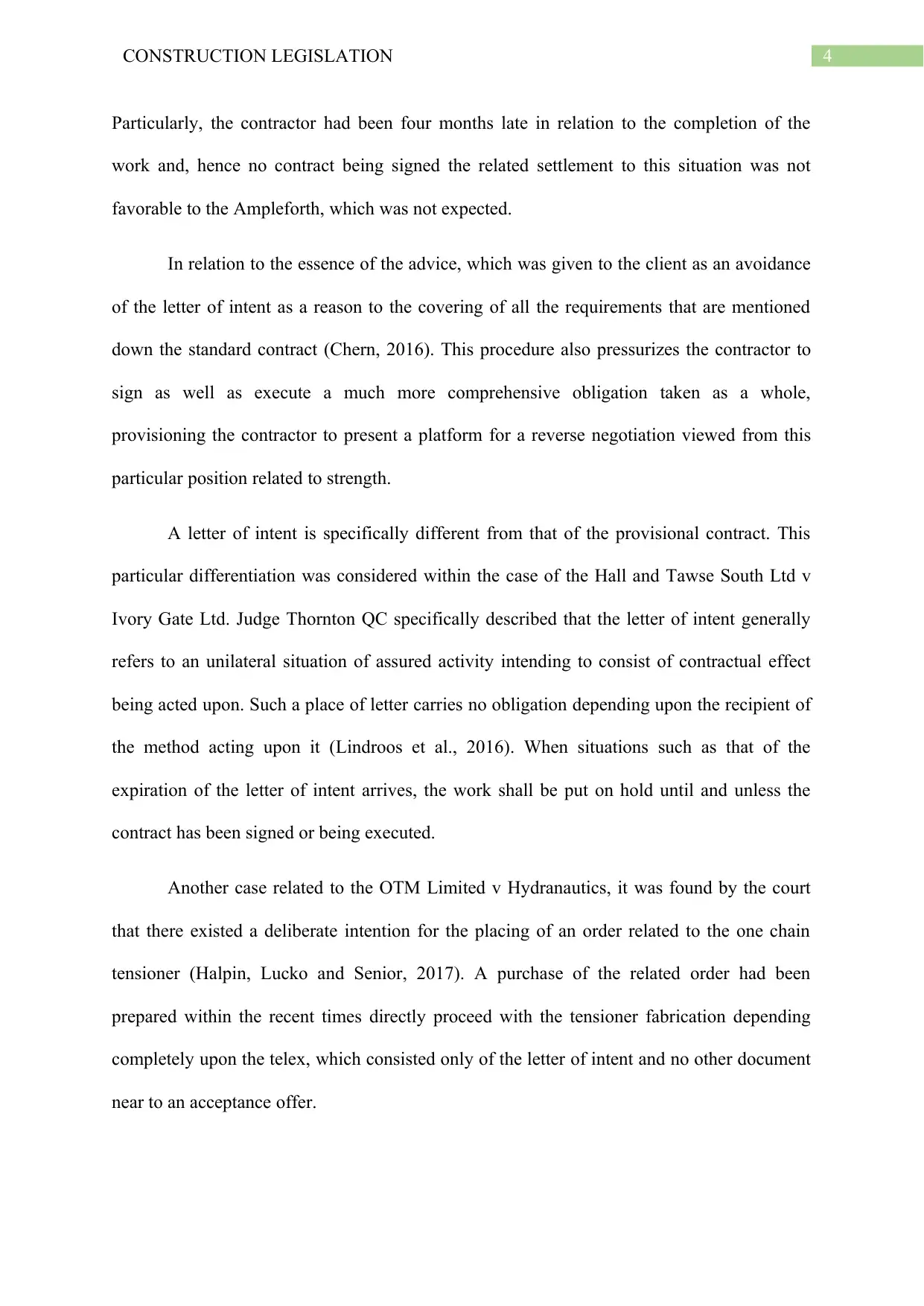
4CONSTRUCTION LEGISLATION
Particularly, the contractor had been four months late in relation to the completion of the
work and, hence no contract being signed the related settlement to this situation was not
favorable to the Ampleforth, which was not expected.
In relation to the essence of the advice, which was given to the client as an avoidance
of the letter of intent as a reason to the covering of all the requirements that are mentioned
down the standard contract (Chern, 2016). This procedure also pressurizes the contractor to
sign as well as execute a much more comprehensive obligation taken as a whole,
provisioning the contractor to present a platform for a reverse negotiation viewed from this
particular position related to strength.
A letter of intent is specifically different from that of the provisional contract. This
particular differentiation was considered within the case of the Hall and Tawse South Ltd v
Ivory Gate Ltd. Judge Thornton QC specifically described that the letter of intent generally
refers to an unilateral situation of assured activity intending to consist of contractual effect
being acted upon. Such a place of letter carries no obligation depending upon the recipient of
the method acting upon it (Lindroos et al., 2016). When situations such as that of the
expiration of the letter of intent arrives, the work shall be put on hold until and unless the
contract has been signed or being executed.
Another case related to the OTM Limited v Hydranautics, it was found by the court
that there existed a deliberate intention for the placing of an order related to the one chain
tensioner (Halpin, Lucko and Senior, 2017). A purchase of the related order had been
prepared within the recent times directly proceed with the tensioner fabrication depending
completely upon the telex, which consisted only of the letter of intent and no other document
near to an acceptance offer.
Particularly, the contractor had been four months late in relation to the completion of the
work and, hence no contract being signed the related settlement to this situation was not
favorable to the Ampleforth, which was not expected.
In relation to the essence of the advice, which was given to the client as an avoidance
of the letter of intent as a reason to the covering of all the requirements that are mentioned
down the standard contract (Chern, 2016). This procedure also pressurizes the contractor to
sign as well as execute a much more comprehensive obligation taken as a whole,
provisioning the contractor to present a platform for a reverse negotiation viewed from this
particular position related to strength.
A letter of intent is specifically different from that of the provisional contract. This
particular differentiation was considered within the case of the Hall and Tawse South Ltd v
Ivory Gate Ltd. Judge Thornton QC specifically described that the letter of intent generally
refers to an unilateral situation of assured activity intending to consist of contractual effect
being acted upon. Such a place of letter carries no obligation depending upon the recipient of
the method acting upon it (Lindroos et al., 2016). When situations such as that of the
expiration of the letter of intent arrives, the work shall be put on hold until and unless the
contract has been signed or being executed.
Another case related to the OTM Limited v Hydranautics, it was found by the court
that there existed a deliberate intention for the placing of an order related to the one chain
tensioner (Halpin, Lucko and Senior, 2017). A purchase of the related order had been
prepared within the recent times directly proceed with the tensioner fabrication depending
completely upon the telex, which consisted only of the letter of intent and no other document
near to an acceptance offer.
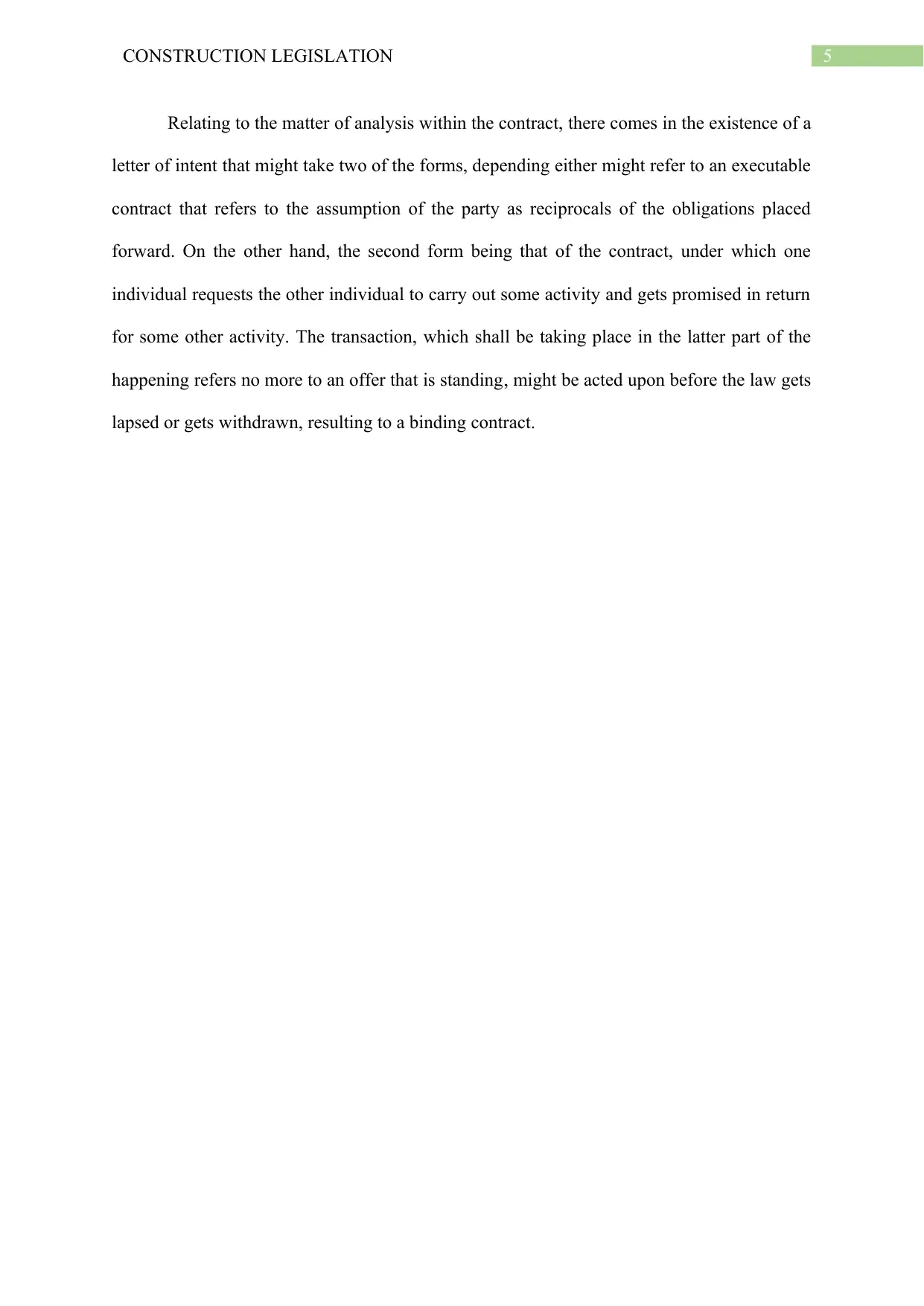
5CONSTRUCTION LEGISLATION
Relating to the matter of analysis within the contract, there comes in the existence of a
letter of intent that might take two of the forms, depending either might refer to an executable
contract that refers to the assumption of the party as reciprocals of the obligations placed
forward. On the other hand, the second form being that of the contract, under which one
individual requests the other individual to carry out some activity and gets promised in return
for some other activity. The transaction, which shall be taking place in the latter part of the
happening refers no more to an offer that is standing, might be acted upon before the law gets
lapsed or gets withdrawn, resulting to a binding contract.
Relating to the matter of analysis within the contract, there comes in the existence of a
letter of intent that might take two of the forms, depending either might refer to an executable
contract that refers to the assumption of the party as reciprocals of the obligations placed
forward. On the other hand, the second form being that of the contract, under which one
individual requests the other individual to carry out some activity and gets promised in return
for some other activity. The transaction, which shall be taking place in the latter part of the
happening refers no more to an offer that is standing, might be acted upon before the law gets
lapsed or gets withdrawn, resulting to a binding contract.
⊘ This is a preview!⊘
Do you want full access?
Subscribe today to unlock all pages.

Trusted by 1+ million students worldwide
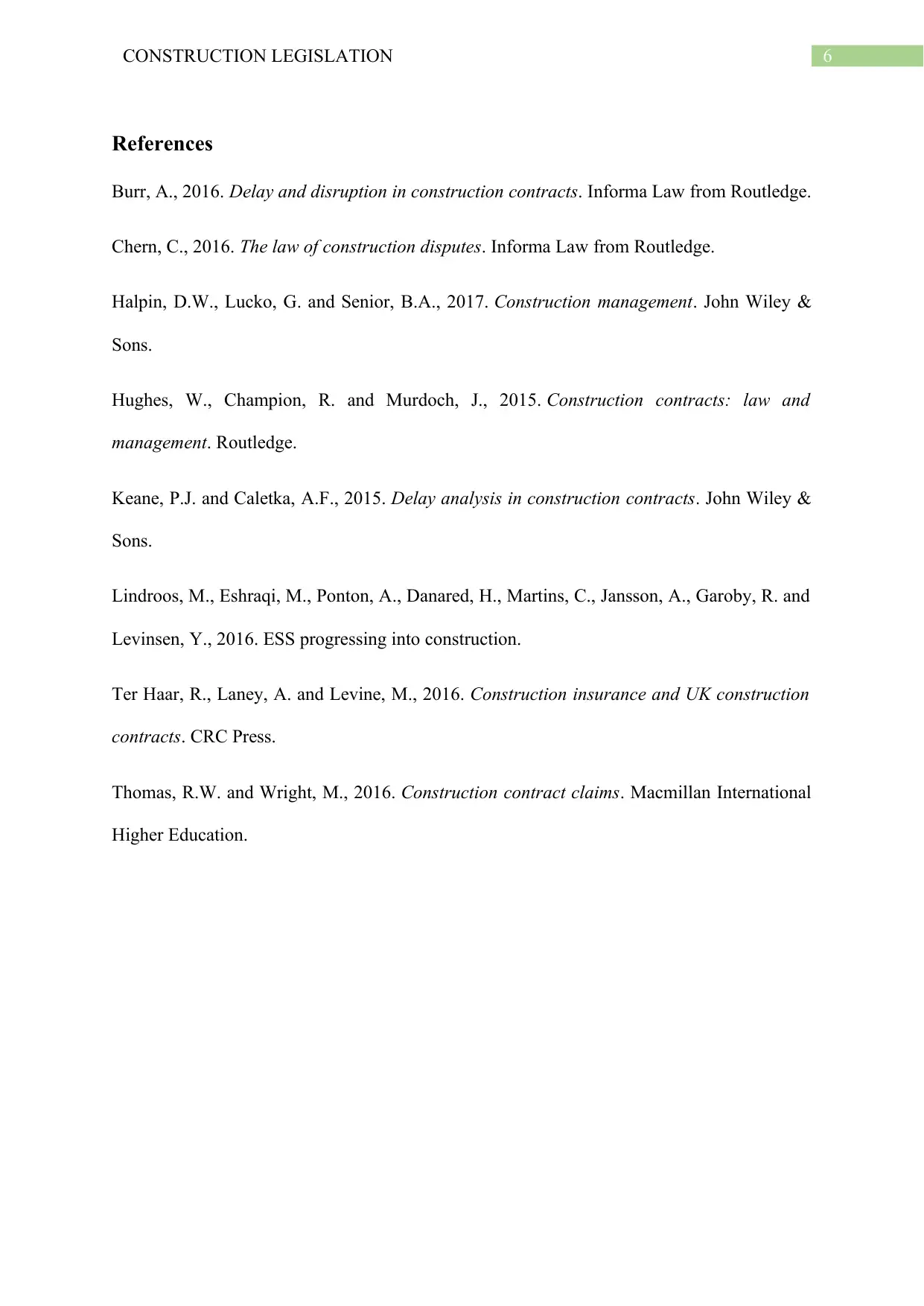
6CONSTRUCTION LEGISLATION
References
Burr, A., 2016. Delay and disruption in construction contracts. Informa Law from Routledge.
Chern, C., 2016. The law of construction disputes. Informa Law from Routledge.
Halpin, D.W., Lucko, G. and Senior, B.A., 2017. Construction management. John Wiley &
Sons.
Hughes, W., Champion, R. and Murdoch, J., 2015. Construction contracts: law and
management. Routledge.
Keane, P.J. and Caletka, A.F., 2015. Delay analysis in construction contracts. John Wiley &
Sons.
Lindroos, M., Eshraqi, M., Ponton, A., Danared, H., Martins, C., Jansson, A., Garoby, R. and
Levinsen, Y., 2016. ESS progressing into construction.
Ter Haar, R., Laney, A. and Levine, M., 2016. Construction insurance and UK construction
contracts. CRC Press.
Thomas, R.W. and Wright, M., 2016. Construction contract claims. Macmillan International
Higher Education.
References
Burr, A., 2016. Delay and disruption in construction contracts. Informa Law from Routledge.
Chern, C., 2016. The law of construction disputes. Informa Law from Routledge.
Halpin, D.W., Lucko, G. and Senior, B.A., 2017. Construction management. John Wiley &
Sons.
Hughes, W., Champion, R. and Murdoch, J., 2015. Construction contracts: law and
management. Routledge.
Keane, P.J. and Caletka, A.F., 2015. Delay analysis in construction contracts. John Wiley &
Sons.
Lindroos, M., Eshraqi, M., Ponton, A., Danared, H., Martins, C., Jansson, A., Garoby, R. and
Levinsen, Y., 2016. ESS progressing into construction.
Ter Haar, R., Laney, A. and Levine, M., 2016. Construction insurance and UK construction
contracts. CRC Press.
Thomas, R.W. and Wright, M., 2016. Construction contract claims. Macmillan International
Higher Education.
1 out of 7
Related Documents
Your All-in-One AI-Powered Toolkit for Academic Success.
+13062052269
info@desklib.com
Available 24*7 on WhatsApp / Email
![[object Object]](/_next/static/media/star-bottom.7253800d.svg)
Unlock your academic potential
Copyright © 2020–2025 A2Z Services. All Rights Reserved. Developed and managed by ZUCOL.




